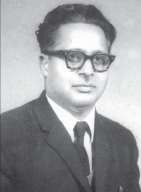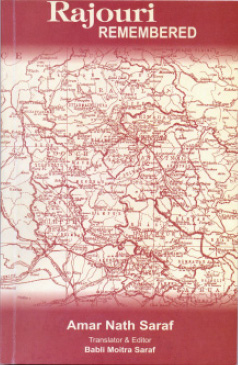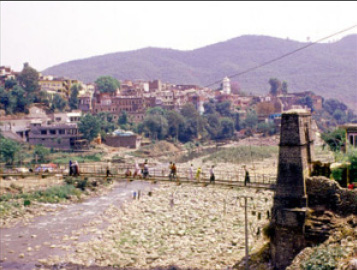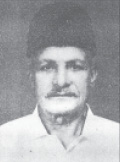Rajouri Did Not
Even Receive A Condolence
By P.N. Raina
Genocide and Exile are two terrible words. Those who experience it can never
get it out of their minds so long as they are alive. Reliving these events
through narratives, oral or historical, is more than recording history an
attempt to come to terms with the self. ‘Rajouri Remembered’, a memoir penned
down by Sh. Amar Nath Saraf to situate the carnage of 1947 in its
socio-historical perspective belongs to this genre.

Sh. A.N. Saraf
Not many of us
knew that Hindus of Rajouri do not celebrate Diwali, the festival of lights.
Mohan Guruswamy’s bone-shaking write-up on Rajouri massacre (1947) in Indian
Express a few years ago took many of us by surprise. On
13th November, 1947, the Pakistani marauders aided by a section of
locals and defectors from State forces mercilessly put to death thousands of
men, women and children at the maidaan, where presently the airfield is located.
The marauders also plundered the town in lust of wealth and booty. Many
survivors continued to live in camps put up by the forces of occupation. The
town was liberated by the Indian Army on
13th April, 1948 the day of Baisakhi festival. ‘Rajouri Remembered’ relives these
events. Sh. Amar Nath Saraf, a former Judge in State Judiciary, writes this
account as an insider.Though he was away in Jammu many his close kith and kin
were part among those people who became victims in the massacre.For Sh. Amar
Nath Saraf and his co-citizens of Rajouri the massacre delineates history into
two phases-shorish se pehle, shorish ke baad.
Shorish, to quote the editor-translator denotes-chaos, anguish,
dislocation, separation, the violence, the massacres and the brutality of the
riots.
Why Sh. Amar Nath Saraf waited for two decades after his retirement
to put on record his memoir on an event which has great historical importance? This is
particularly surprising in view of his great emotional attachment with his home
place-Rajouri and the paucity of recorded material on it. On
25 November, 2006 Sh. Amar Nath Saraf was visited by a profound
tragedy. He lost his wife, a companion of more than five decades and whose
family had done so much to rehabilitate Sarafs in the immediate aftermath of
massacre. The mourners, many of whom came from Rajouri refreshed his longings
for his native Watan and sharpened his sense of loss. The occasion provided an
opportunity for the author’s talented daughter-in-law, Babli Moitra, a Bengali
by ethnicity and sociologist by training to record narratives about Rajouri,
particularly about the carnage of 1947. She also translated the memoir written
down by her father-in-law. He put at her disposal all the records-papers,
newspapers and chronicles to put the events of 1947 Rajouri in proper
perspective. Sh Amar Nath Saraf is deeply pained at the treatment meted out to
the victims of Rajouri, who he says received neither ‘financial compensation’
nor ‘condolence’. He laments that such a horrendous massacre of contemporary
times is being described vaguely by chroniclers as ‘a local uprising in Poonch
area’ or ‘some excesses’ committed by marauding Pashtun tribesmen and victims
are all reduced to statistics. Sh. Saraf regrets that Rajouri remained unique in
the sense that it was not given even the distinction of being considered a
statistical figure. He is bitter when he says ‘we as the survivors have
consented to that erasure of memory’. He recalls in his Foreward that ‘the
biggest misfortune is to have to leave one’s land, one’s people. The most
miserable existence is that of an exile’. The loss of his wife heightened his
sense of loss for his Watan, Rajouri. The memoir has been ably edited by Babli
Moitra Saraf. The valuable historical material-’Jammu Kashmir State Ke Rajouri
Nagar Ka Khooni Itihaas’ by Lala Pishori Lal Jhinjotia, ‘Kashmir Mein Chand Roz’
by Mirza Faqir Mohd. Rajorvi (1984), 5-part article by Sh. Narinder, editor of
‘Pratap’ (Delhi),
Rajouri Reclaimed by Sh. K.D. Maini etc. has been consulted. The editor has
focussed on the event using narrative voices as perspectives on it.
on record his memoir on an event which has great historical importance? This is
particularly surprising in view of his great emotional attachment with his home
place-Rajouri and the paucity of recorded material on it. On
25 November, 2006 Sh. Amar Nath Saraf was visited by a profound
tragedy. He lost his wife, a companion of more than five decades and whose
family had done so much to rehabilitate Sarafs in the immediate aftermath of
massacre. The mourners, many of whom came from Rajouri refreshed his longings
for his native Watan and sharpened his sense of loss. The occasion provided an
opportunity for the author’s talented daughter-in-law, Babli Moitra, a Bengali
by ethnicity and sociologist by training to record narratives about Rajouri,
particularly about the carnage of 1947. She also translated the memoir written
down by her father-in-law. He put at her disposal all the records-papers,
newspapers and chronicles to put the events of 1947 Rajouri in proper
perspective. Sh Amar Nath Saraf is deeply pained at the treatment meted out to
the victims of Rajouri, who he says received neither ‘financial compensation’
nor ‘condolence’. He laments that such a horrendous massacre of contemporary
times is being described vaguely by chroniclers as ‘a local uprising in Poonch
area’ or ‘some excesses’ committed by marauding Pashtun tribesmen and victims
are all reduced to statistics. Sh. Saraf regrets that Rajouri remained unique in
the sense that it was not given even the distinction of being considered a
statistical figure. He is bitter when he says ‘we as the survivors have
consented to that erasure of memory’. He recalls in his Foreward that ‘the
biggest misfortune is to have to leave one’s land, one’s people. The most
miserable existence is that of an exile’. The loss of his wife heightened his
sense of loss for his Watan, Rajouri. The memoir has been ably edited by Babli
Moitra Saraf. The valuable historical material-’Jammu Kashmir State Ke Rajouri
Nagar Ka Khooni Itihaas’ by Lala Pishori Lal Jhinjotia, ‘Kashmir Mein Chand Roz’
by Mirza Faqir Mohd. Rajorvi (1984), 5-part article by Sh. Narinder, editor of
‘Pratap’ (Delhi),
Rajouri Reclaimed by Sh. K.D. Maini etc. has been consulted. The editor has
focussed on the event using narrative voices as perspectives on it.
VALUABLE MEMOIR:
‘Rajouri Remembered’ is valuable on many counts. Through a personal
memoir it tells us so much about the social life of Hindus of Rajouri and the
intercommunal relations in pre-1947 period. The author has drawn good
biographical sketches of two outstanding personalities of Rajouri - Lala
Narsingh Dass Kaila and Dr. Malik Ram Gupta. We are also told about the custom -
how Hindus of Rajouri would gave their babies in temporary adoption to Labhan as
for ensuring their longevity. Such customs fostered good inter-communal
relations. The memoir focuses on the events leading to massacre, the carnage and
the displacement/survival trauma of the victims/refugees. There is a brief
account of Rajouri’s history. Till 1194 Rajouri was governed by Hindu Kings. The
Jarral dynasty came to power when a Punjabi Durbari, Noorddin led revolt against
Raja Amna Pain and killed him. The Jarrals ruled till 1846, Rahimullah Khan
being the last ruler. In 1847 Maharaja Gulab Singh appointed Mian Hathu as
Governor. Previously a part of Bhimbar district, Rajouri was later clubbed with
Reasi district (1904), Poonch district (1947) and became separate district in
1947.
EVENTS LEADING TO
NOVEMBER 1947:
In 1932 in the wake of agitation by Muslim Conference the entire
J&K State
was rocked by communal violence. In Rajouri tehsil also many people died in the
riots. Lala Pishori Lal’s family was uprooted from Jhinjot Kedi and trekked for
three days to reach Rajouri town, which had preponderance of non-Muslims.
Rajouri town was saved by the timely arrival of State forces. Though Rajouri was
not affected much, the fear started lurking in the minds of people on what would
be the condition of the minority in the days to come. Next event was partition
of the Indian sub-continent. On 14th August, 1947 there was large-scale communal
violence in J&K. In Rajouri Hindus poured into town from neighbouring areas,
while town’s Muslims retreated into villages. The leaders of both the
communities proposed to set up an Aman Committee. For some reasons this proposal
was thwarted. Soon there was tribal invasion of the state. After capture of
Sensa in Mirpur by Pakistan the Maharaja had sent forces under Col. Rehmatullah
Khan to defend Rajouri. As part of the Pakistani conspiracy Rehmatullah and
Major Nasrullah had joined the Raiders. They killed the Gorkha sepoys of their
own companies, collected more deserters on the way and reached Chacchera jungles
in the vicinity of Rajouri on
28th October, 1947. Rajouri had just 2 platoons to defend it
self. Col. Rehmatullah, well familiar about the layout of the terrain and
vulnerable defence of Rajouri, began to put pressure on the town. Two tehsils of
Poonch had already come under the sway of raiders by 24th October. As Col.
Rehmatullah Khan reached Chacchera, Sardar Ibrahim Khan sent another group of
Pakistanis under Sakhi Diler to join him in first week of November. Mirza Faqir
Mohd. writes that he and other prominent citizens of Rajouri were already in
touch with raiders. He was President of the local Muslim Conference and was also
active in interactions with the Rajouri’s Hindu minority.

A view of Rajouri
Town.
DESPERATE
SITUATION:
With Rajouri so vulnerable, local RSS volunteers asked the SHO to
release ammunition to them for defence of Rajouri, a demand which was rejected
by him. Many members of the minority community left for
Jammu though RSS
tried to hold them back thinking that ‘strength lay in numbers’. Thousands of
members of the minority community began pouring into the town. The local
minority population was 38 thousand at the time of attack. As situation turned
grim many people of Rajouri met Sh. Meher Chand Mahajan, the Prime Minister in
Jammu, making request for more troops. He did send some units towards Rajouri
but Sheikh Abdullah, the head of the Emergency administration diverted these to
Reasi to restore law and order there. On the evening prior to attack the members
of the minority community learnt that no Indian army was coming to defend them.
Some members managed to leave under cover of night. Those who remained in
Rajouri included persons unable to move. There were yet others who were
confident that their own status as prominent citizens would buy them immunity
from attackers. They included Messers Dina Nath Kaila and Lala Narsingh Dass,
maternal uncle of Sh. AN Saraf. Lala Narsingh Dass had been among the first
members from the local minority community to join National Conference in 1941 at
the instance of Sheikh Abdullah. Lala had progressive ideas and attacked usury
in no uncertain terms.
SAFE PASSAGE
NEGOTIATIONS:
In the few days preceding the attack Lala Dina Nath Kaila had been
procuring deadly potassium cyanide from labs. of local school as an emergency
measure. Before the carnage he and Lala Narsingh Dass were negotiating peace and
safe passage, using their good contacts with prominent leaders of local Muslim
Conference. This was on 8th November, with raiders stationed all around. Lala
Narsingh Dass also moved a proposal to set up a Debt cancellation board to
provide relief to Muslim peasants. This was conveyed to Mirza Faqir Ahmed and
Mirza Mohammad Hussain, the local leaders of MC. Mirza Faqir corroborates in his
memoir that Lala Narsingh Dass also agreed to pay Rs 3 crores to raiders along
with Rajouri town besides wholesale conversion and allegiance to
Pakistan to save
the minority community. In case this proposal was not acceptable then the
minority community be provided safe passage to
Delhi,
he had asked. The proposals were okayed by Muslim conference leaders of Rajouri,
who took these to raiders’ camp at Karaiyan on 8th November. When Col.
Rehmatullah Khan and Sakhi Diler rejected these proposals, Mirza Faqir Ahmed and
other Muslim Conference leaders insisted on safe passage. On the strong
insistence of Mirza Faqir Mohd. the raiders’ leaders sent a message to the
minority community on 8th November, asking them to move to Maidaan of Baidka
with their families in case they wanted safe passage to Delhi. The messenger
delivered it to Tehsildar, Pt. Harji Lal. It is not known what he did with the
message but he himself deserted Rajouri on the same night, leaving people of
Rajouri to their own fate. He even carried state forces along for his
protection. On 9th November Col. Rehmatullah Khan laid the seige

Col. Rehmatullah Khan
of Rajouri and
resorted to firing. This was replied to some extent by weakened Gurkha platoon
and RSS volunteers. On 10th November there was no resistance to the raiders. The
local minority community was desperate. It sounds intriguing why no messenger
from local Muslim Conference leaders was willing to take the conditions of
minority community in writing to raiders’ leaders on 10th November.
KILLINGS:
The minority community had decided that the moment the fall of the
town became imminent a bugle would be sounded to call people to assemble at the
maidaan. Committing suicides and resorting to brutal honour killings of women
and children was, in the minds of the minority community, a fate better than
falling into the hands of the raiders. Prominent members of the community in
full public view were the first to consume poison. ‘Rajouri Remembered’ gives
graphic details about the sad event of suicide and honour killings. All this was
witnessed 2-3 weeks before in Muzaffarabad, Ningal (Sopore), Handwara etc. Even
before the physical occupation of Rajouri the localities of the minority
community were razed to the ground. Many women and children were abducted and
sold in Kotli by raiders.
CARNAGE:
The men were rounded up from neighbouring areas, taken to the
Maidaan and brutally massacred. The raiders had orders from their officers to
use axes, daggers and swords in massacring the members of the minority
community. More than 4 thousand members were killed in the carnage of 11th
November. Massacre began on 10th of November and continued for three days.
However, some people were lucky enough to run away and seek refuge in the
surrounding villages with sympathetic families from the majority community. Some
of them were however hunted down and killed. To escape riotous mobs many
survivors even after escaping from Rajouri committed suicide by swallowing
poison. There are chilling stories of killings, suicides etc. narrated by the
author. The latter has also described stories of survivors how they were rescued
by the saner elements and given shelter by them. Often these families of saner
elements were threatened and humiliated by the riotous mobs and elements in
league with raiders. Pishori Lal was one such survivor, who lived to write the
chronicle which describes at length all that happened during those days and
thereafter. Soon after Rajouri fell a message was sent to the survivors to
report at a ‘relief camp’ in town. The survivors received the news with
skepticism. Lala Narsingh Dass and Durga Dass went to the Raiders’ Camp in
Gurdan to consult the raiders’ leader Aslam Khan about the move. His bodyguards
in an act of treachery shot them dead. The author gives credit to Mirza Faqir
Mohd. for reconciling many families who had got separated. He helped to locate
the abducted and used his connections in the government to send these people
back to
India.
‘Rajouri Remembered’ is a welcome addition to the growing corpus of ‘partition
literature’. Its publication coincides with 60th Anniversary of the raiders
invasion of the state. What better tribute can be paid to the martyrs of Rajouri
carnage than recounting their martyrdom?
Source: Kashmir
Sentinel
| 